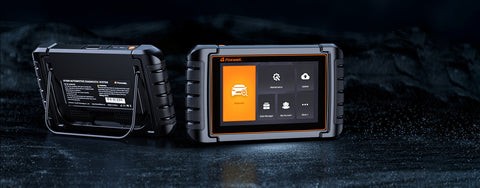The evolution of automotive technology has brought about sophisticated vehicle management systems. Modern cars are replete with electronic sensors and components that, while enhancing performance and safety, also require advanced diagnostic tools. The On-Board Diagnostic (OBD) scanner has emerged as an indispensable tool for mechanics and car enthusiasts alike, providing crucial insights into a vehicle’s health. Among the advanced features of OBD2 scanners, bidirectional control stands out as a powerful capability. This article delves into the intricacies of Obd2 Bidirectional control, explaining its functionality, benefits, and how it enhances automotive diagnostics.
How Bidirectional Control Functions in OBD2 Scanners
At the heart of a vehicle’s electronic system is the Electronic Control Unit (ECU), often referred to as the car’s computer. The ECU monitors and manages various vehicle functions, storing data related to performance and malfunctions in its memory. An OBD2 scanner acts as a communication bridge to this ECU via the OBD port, retrieving diagnostic information. This diagnostic tool accesses the vehicle’s memory to extract fault codes, also known as Diagnostic Trouble Codes (DTCs), which pinpoint potential issues. With modern vehicles increasingly relying on sensor-driven systems managed by the ECU, OBD2 scanners have become essential for identifying problems.
Beyond simply reading fault codes, bidirectional control elevates the diagnostic process. It enables the OBD2 scanner to not only receive information from the vehicle but also to send commands to the vehicle’s systems. This two-way communication is crucial for performing active tests and component testing, going beyond surface-level diagnostics to uncover deeper issues. Reprogramming capabilities are another significant aspect of advanced OBD2 scanners, further extending their utility in vehicle maintenance and repair.
Bidirectional control, therefore, is a system that both diagnoses problems and actively tests vehicle performance. While scanning for fault codes provides a starting point, there are situations where a mechanic needs to command specific tests to confirm suspected issues that may not be apparent from a standard scan. This active approach to diagnostics is where the true power of bidirectional control lies.
Exploring Different Types of Bidirectional OBD Scanners
The market offers two primary categories of bidirectional OBD scanners, each with distinct characteristics:
-
Vehicle Manufacturer Scanners: These scanners are developed by car manufacturers themselves. They are meticulously designed to comprehensively interact with all systems within their specific vehicle brands, ensuring deep and accurate diagnostics. Manufacturers invest heavily in these tools, aiming for complete diagnostic coverage.
-
Aftermarket Scanners: Produced by third-party companies, aftermarket scanners aim to offer broad compatibility across various vehicle makes and models. However, the extent of bidirectional control in these scanners depends on the accessibility granted by the original vehicle manufacturers. Implementing robust bidirectional control can be complex for aftermarket manufacturers due to safety and accountability considerations. For instance, commanding engine speed increases when certain safety conditions are not met could lead to damage or hazardous situations. Aftermarket manufacturers must carefully navigate the protection protocols established by car manufacturers to ensure safe and effective bidirectional functionality.
Understanding the Basics of Bidirectional Testing
Bidirectional testing significantly reduces diagnostic time when applied correctly. Consider a scenario where a car fails to start. Initial checks, such as connecting a fuel pressure gauge and cycling the key, might reveal no fuel pressure. At this point, it’s unclear whether the issue is a command problem, a circuit malfunction, or a faulty component. This is where bidirectional control becomes invaluable.
Using a bidirectional OBD2 scanner, a mechanic can access a fuel pump command. By activating the fuel pump directly through the scanner, and observing the fuel pressure gauge, the mechanic can quickly determine if the fuel pump circuit and pump are functioning correctly. If fuel pressure is restored upon command, it indicates that the pump and circuit are operational, shifting the focus to other potential causes of the no-start condition, such as a faulty fuel pump relay or ECU command issue. This example illustrates the efficiency and precision that bidirectional control brings to automotive diagnostics.
Utilizing an OBD2 Scanner Effectively with Bidirectional Capabilities
While numerous OBD2 scanners from various manufacturers are available, they generally share user-friendly functions. Foxwell OBD2 scanners are known for encompassing essential OBD2 functionalities and offering advanced features like bidirectional control. When a check engine light or warning light appears, a Foxwell OBD2 scanner allows for a detailed diagnostic test to pinpoint the problem, often providing in-depth analysis and potential solutions.
Here are the fundamental steps for using an OBD2 scanner:
- Ensure the vehicle’s engine is off before connecting the OBD2 scanner to the OBD port.
- The scanner will power on, and you can then turn the car’s ignition to the “ON” position without starting the engine.
- Input necessary vehicle information into the scanner, such as engine type, make, model, and VIN.
- The OBD2 scanner will read and display data on its screen.
- Utilize bidirectional control to command specific tests if further diagnostic clarity is needed.
Adhering to these guidelines is crucial for accurate results and safe scanner operation:
- Always consult the OBD scanner’s user manual to understand its specific operation and features.
- Connect to the OBD port carefully to avoid damaging pins on the scanner or vehicle connector.
- Turn off the vehicle’s engine before connecting or disconnecting the scanner to prevent potential software issues.
- Leverage bidirectional control to command component tests when standard scans are inconclusive, allowing for active troubleshooting.
Selecting the Right Bidirectional OBD2 Scanner
The market presents a wide array of OBD2 scanners with live data capabilities. Choosing a scanner that is compatible with your vehicle and offers the necessary features is essential.
Foxwell OBD2 scanners are a popular choice in automotive diagnostics, offering a diverse range of models with features tailored to different vehicles and diagnostic needs. Notable models include:
-
Foxwell NT650 Elite: Extending beyond basic OBD2 functions, the Foxwell NT650 Elite provides over 30 maintenance services, including robust bidirectional control. It is compatible with a wide range of brands, including Toyota, BMW, and GM, covering models from 1999 to 2022. With free lifetime updates and advanced diagnostic capabilities, it’s well-suited for professionals.
-
Foxwell NT530: The NT530 Multi-System Scanner is designed to support frequently used service and coding functions, offering OE-level diagnostics for numerous car brands. Its enhanced hardware and software facilitate easier bidirectional control, enabling technicians and enthusiasts to diagnose and address issues with greater speed and precision.
Conclusion: Embracing Bidirectional Control for Enhanced Diagnostics
The OBD2 scanner has revolutionized automotive diagnostics, empowering vehicle owners and technicians with the ability to understand and address car issues effectively. Bidirectional control further enhances this capability, allowing for active component testing and deeper diagnostics beyond simple code reading. Foxwell OBD2 scanners, with their range of models and advanced features, stand out as valuable tools for elevating the automotive diagnostic experience, providing users with the control and insights needed to maintain vehicle health and performance.
FAQs on OBD2 Bidirectional Control
How Crucial is Bidirectional Control in an OBD2 Scanner?
Bidirectional control is vital as it allows users to actively command vehicle functions, testing components that might not be responsive during passive diagnostic scans. This active testing is essential for pinpointing specific issues and ensuring accurate diagnoses.
Why is an OBD2 Scanner Necessary?
OBD2 scanners provide direct access to your vehicle’s internal systems, enabling you to diagnose problems before seeking professional repair services. This empowers informed decision-making and can potentially save time and costs associated with unnecessary repairs.
What are the Advantages of Using a Bidirectional OBD2 Scanner?
Bidirectional OBD2 scanners offer deeper diagnostic capabilities, improve troubleshooting efficiency, and can be more cost-effective in the long run by enabling more precise diagnoses and targeted repairs. They reduce guesswork and allow for proactive vehicle maintenance.

